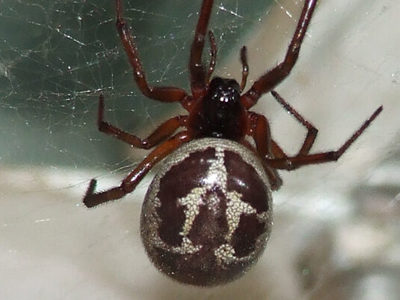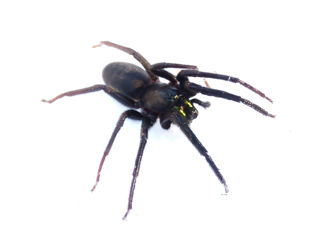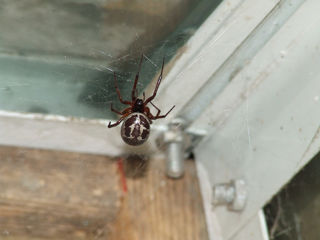
I spied a spider
20th Oct 2021

Have you ever been bitten by a spider? I have.
I was washing my face and there was a lace-web spider – Amaurobius ferox – in the flannel that I was unaware of. I felt a stinging sensation on my forehead and the spider fell out into the sink. There was a small localized pain that lasted maybe an hour as it faded away and I suffered no ill-effects. The numerous bee and wasp stings that I have suffered over the years were all more painful and prolonged. My friend was bitten by the same species (which I identified from a photo that she posted on Facebook) that had secreted itself in a bath towel, to similar effect. Spider bites are not common, but more unusual is being able to identify the culprit. As a consequence, certain species are often scapegoated, particularly the false widow.
One of the bigger kinds, the noble false widow, Steatoda nobilis, arrived here in the 19th century in bananas from the Canary Islands and its spread has increased rapidly in recent years, most likely accelerated by climate change. It is the headline-maker that undoubtedly you will have heard of. Make no mistake, the larger false widows can and do bite under certain circumstances, particularly if they are squeezed or trapped against the skin, for example, and such accidents can occur when people put on gloves or boots where a spider is housed. Reports of the bite vary from ‘a slight sting and a little numbness in the area’ to ‘similar to boiling water being poured onto her skin in the affected area’, with associated blistering. In the latter case the person was bitten three times. Spiders can regulate how much venom they inject, hence the resultant effects may depend on how many times a person is bitten, and how much threat the spider feels it is under (e.g. if it is slowly being squashed to death in your clothing). False widow venom shares two-thirds of its toxins with that of the true black widow and so, while the majority of human victims display mild to moderate symptoms, it has the potential to deliver stronger effects. In addition, these (and some other spiders) harbour potent bacteria that can cause nasty infection around the wound.
It is possible to live happily alongside these spiders. Friends of mine have lived with a colony of noble false widows in their home, boat and garden buildings for many years without mishap. Over the years I have removed several and kept them for study. They are fascinating to observe and are actually quite dainty in their behaviour. When they are alerted to an insect’s presence (say, a bee or a wasp) by the vibration of the web they use their long forelegs to sense the strands that will bring them close to it. As they approach more closely, again using a long front leg they cautiously assess the size of the intruder by not quite touching them. The spider then turns about-face and, this time using their long back legs, reels out copious amounts tough silk from the spinnerets beneath the abdomen, rapidly wrapping the prey until it is immobilized. Then, and only then, does the spider approach and deliver two or three delicate ‘kisses’, withdrawing to a safe distance until all struggles cease.

By contrast, another spider that I have kept in captivity, the impressive green-fanged tube-web spider, Segestria florentina, charges from its retreat like an express train from a tunnel, seizes its hapless victim it in its jaws and drags it backwards into its lair. This beast is large and imposing by British standards, not quite the biggest but close, and is not a native but another that has been accidentally introduced (from the Mediterranean) and established in scattered localities, especially ports, since Queen Victoria’s day. It has also spread inland in southeast England in the last twenty years. It is black in colour and close examination of the head end will reveal two things; it ‘only’ has six eyes (most spider species have eight), and it has shining metallic green ‘jaws’ (technically known as chelicerae) upon which the fangs are set – so not really green-fanged. Apart from the shock and fear factor that this spider would instill upon sight or bite, there have been couple of authenticated examples of people being bitten. In one it was described as ‘A sharp and painful bite; felt like a deep injection’. In this case the pain subsided after six hours. Tube-web spider venom has been analysed by Russian scientists and found to contain two different nerve-toxins and, perhaps not surprisingly, an insecticide!
Given a choice, I would choose not to be bitten. During my long interest in spiders I have never been bitten by a spider through handling them …mainly because I don’t. Whatever size or species of spider, I capture and manipulate them in a suitable transparent container. That way there is the no risk to the spider – most are small and delicate, not to mention disobedient – and no risk to me. I recommend that, instead of cupping spiders in your hands to eject them from your home – at least two of the documented false widow bites occurred in that scenario – you keep a see-through plastic tub handy. That will give you chance to admire and perhaps even identify your visitor. They are, after all, amazing creatures.
During Halloween half-term at Wildwood we will be having a spider day on Tuesday October 26th when we search the park for spiders and make some fun spider crafts. I will bring in a specimen or two to thrill you with. See you then.
